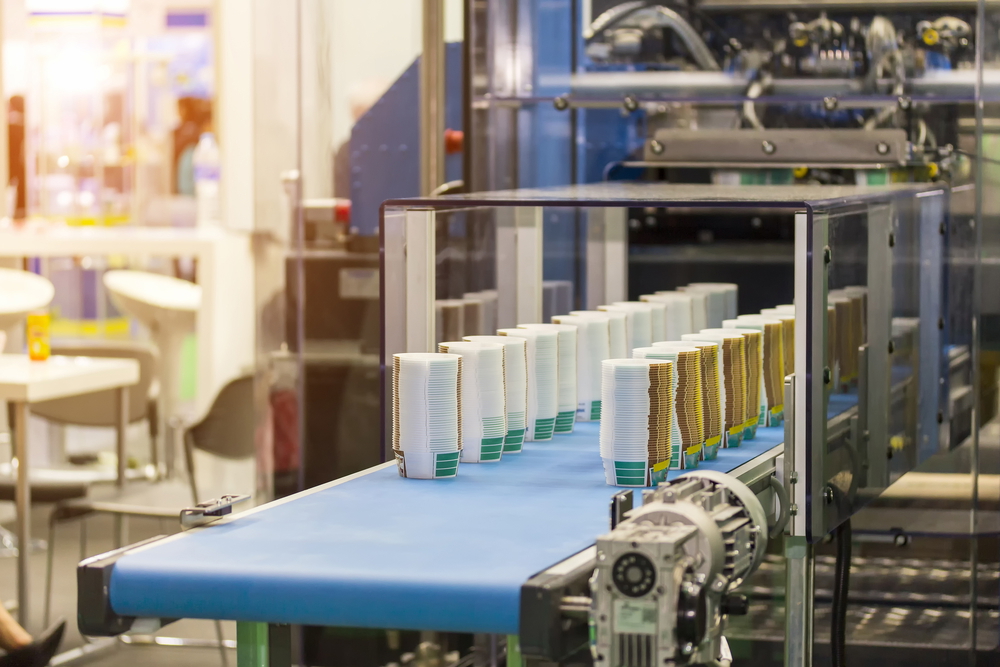What Makes a Good Paper Cup?
By Anttoni Taimela · 10. July 2024
What makes a good paper cup? It’s a combination of quality materials, environmental friendliness, effective insulation, safety, durability, and customization.
This article explains each factor, helping you choose the right paper cup for your needs.
Material Quality and Sourcing

The cornerstone of a good paper cup lies in the quality of the raw materials used. High-quality materials directly influence the cup’s durability, functionality, and sustainability.
Durability, insulation, and environmental impact are important factors to consider when choosing paper cup materials.
Common materials used in paper cups include:
- PE-coated paper: favoured for its excellent insulation properties and water resistance, making it a popular choice for hot beverages ☕
- PLA-coated paper: derived from renewable resources, offers an environmentally-friendly option without compromising on performance 🌱
- Biodegradable water-based barrier coated paper: made from plant-based materials, provides a sustainable alternative, aligning with the growing demand for eco-friendly packaging solutions. 🌿
To ensure the safety and compliance of paper cups, it is important to:
- Source materials from credible suppliers.
- Purchase from reputable suppliers to guarantee that the paper cups meet safety standards and regulatory requirements.
- Comply with the EU Corporate Sustainability Due Diligence Directive, which requires companies to identify and mitigate risks to human rights and the environment throughout their supply chain, impacting many US-based vendors operating in the EU.
Environmental Impact

The environmental impact of paper cups is a significant concern. The manufacturing process requires cutting down approximately 6.5 million trees annually, contributing to deforestation and habitat loss.
Additionally, the carbon footprint of paper cups that end up in landfills is substantial, with an annual emission of 152,000 tonnes of carbon dioxide.
Recyclable paper cups are not as eco-friendly as they might seem. Most standard recyclable paper cup options consist of virgin paper with a laminated plastic coating, making them difficult to recycle.
These cups cannot be recycled with paper, leading to confusion in the waste stream and often ending up in landfills.
To recycle paper cups effectively, proper separation and recycling facilities are necessary. ♻️
Heat Retention and Insulation
When it comes to enjoying hot drinks, proper insulation is key. The outer layer of a paper cup, typically made from paperboard, provides essential heat retention and insulation. Double-walled paper cups offer extra protection, keeping drinks hot for up to three hours.
This is particularly beneficial for takeout customers who want to drink hot beverages and ensure they stay warm on the go. 🔥
Customers’ overall satisfaction can be enhanced by using high-quality double-walled paper cups, which protect them from hot beverages.
Key factors in ensuring heat resistance include 300 GSM boards and PLA insulation, which provide resilience and reduce heat conduction.
By investing in well-insulated paper cups, businesses can ensure a positive drinking experience for their customers.
Safety and Food-Grade Standards
Safety is paramount when it comes to paper cups. Using food-grade paper boards ensures that the materials in contact with the beverage are safe for human consumption.
Non-toxic, water-based food-grade inks dominate the packaging industry, eliminating health concerns during the printing process.
For regulatory adherence and safety, printed disposable coffee cups should bear compliance marks.
These marks assure customers that the cups meet safety standards, preventing potential health risks associated with improperly cured inks or harmful chemicals.
By prioritising safety and food-grade standards, businesses can protect their customers and build trust in their products. 🛡️
Durability and Leak Resistance

Durability and leak resistance are critical factors in the performance of paper cups. Leakage and absorbency issues can negatively impact the user experience and lead to drink wastage.
To combat these problems, specialised paper types such as Couche, SBS, and PE-coated paper are used to enhance water resistance.
Increasing the thickness of paper cups, typically to around 220-250 grams per square metre, improves their water resistance and durability.
Additionally, applying embossed wave technology boosts the elasticity and water resistance of the cups, providing a more robust solution.
Coating the interior of paper cups with a thin layer of wax or plastic further enhances their tightness and water resistance.
These methods ensure that the cups can hold liquids securely without leaking, providing a reliable option for both hot and cold beverages. 💧
Customization Options
Customization plays a significant role in branding and marketing efforts. There are different printing methods available for custom cup printing, each with its own advantages:
- Offset printing: renowned for its precision and colour accuracy, ensuring a consistent and professional look. Ideal for larger print runs.
- Digital printing: offers agility and versatility, making it ideal for shorter print runs and intricate designs. Allows for quick turnaround times.
- Flexographic printing: cost-effective for high-volume orders. Uses environmentally friendly water-based inks.
The CMYK colour system is essential for accurate colour reproduction on branded takeaway coffee cups, while the Pantone Color Matching System ensures precise colour consistency.
Customising lids, straws, and doilies to fit your brand’s paper cup design can enhance the overall aesthetic and branding experience.
Businesses can reinforce their brand identity and foster customer loyalty by creating a unique and memorable experience through a range of customization options. 🎨
Cost Efficiency
To maximise profitability while maintaining customer satisfaction, it is important to balance the paper cup size, portion control, and raw material costs.
Larger cups may tempt businesses to serve larger portions, leading to increased costs, but keeping portions strictly controlled ensures consistency in servings and costs.
‘Upsizing’—offering a larger size for an extra cost—can bolster business figures and contribute to increased profitability.
Larger cup sizes can lead to higher costs because they require more raw materials and a more complex manufacturing process. This results in increased production expenses.
Charging a premium for larger drinks can offset these costs, leading to a significant profitability boost. 📈
Factors like legislation, market needs, and consumer tastes should also be considered when choosing paper cups.
By carefully selecting the right paper cup sizes, businesses can strike a balance between cost efficiency and customer satisfaction.
Customer Experience
The design, size, and functionality of paper cups play a significant role in shaping customer satisfaction and loyalty.
Designing cups with narrow mouths and curved rims helps to minimise spills and overflows, enhancing the drinking experience.
Distinctive and attractive cup designs can inspire customers to return for more, acting as a silent marketing tool.
High-quality printed paper cups enhance customer loyalty by providing a pleasant drinking experience and aesthetic appeal.
The size of a cup moulds the beverage experience, affecting customer satisfaction and comfort with the beverage.
For businesses, understanding and engaging with customers’ preferences is important. By offering a range of paper cup sizes and designs tailored to customer needs, businesses can meet expectations and foster loyalty. ❤️
Eco-Friendly Alternatives
As awareness of environmental issues grows, eco-friendly alternatives to traditional disposable cups, such as paper cups, are becoming more popular.
Biodegradable and compostable paper cups, made from plant-based materials like cornstarch, offer a sustainable option.
These cups can break down in industrial composting facilities within 120 days, reducing greenhouse gases and landfill costs. Similarly, paper bags provide an environmentally friendly alternative to plastic bags. 🌎
The PLA coating for biodegradable paper cups is made from raw materials such as sugar cane, sugar beets, and cornstarch.
These materials are used to create a sustainable alternative for traditional paper cup coatings. Home composting at temperatures of about 65°C can transform these cups into manure, further reducing their environmental impact.
Nearly all standard paper cup sizes now come in environmentally friendly versions made from sustainably sourced paper, aiming to reduce the carbon footprint.
By choosing eco-friendly alternatives, businesses can contribute to a healthier environment and appeal to environmentally conscious customers.
In fact, most paper cups available today are designed with sustainability in mind.
Role of Lids and Accessories
The functionality and convenience of paper cups, especially when used as a paper coffee cup, can be enhanced by the use of lids and accessories, such as a plastic lid.
Sip-thru lids, for example, reduce the risk of spilling hot beverages while adding convenience for on-the-go consumption. Eco-friendly lids and coffee sleeves enhance the paper cup experience by ensuring a secure fit and maintaining temperature.
These components are integral to the takeaway packaging experience, providing practicality to customers and enhancing the overall functionality of paper cups. 🥤
Innovations in Paper Cup Technology
Advancements in paper cup technology are continually pushing the boundaries of sustainability and efficiency.
The use of biodegradable materials in manufacturing helps reduce the environmental impact of paper cups.
Bio-based plastics as coatings improve the compostability and recyclability of these cups, making them a more eco-friendly option.
Exploring rapidly renewable resources, such as bamboo and sugarcane, offers new possibilities for creating sustainable paper cups.
Some benefits of using these resources include:
- Reduced environmental impact
- Lower carbon footprint
- Renewable and biodegradable materials
- Improved structural integrity and leak resistance
These advancements in moulding techniques have improved the performance of paper cups, making them a more sustainable option for various applications, as the cups are made with precision and care.
Automated quality control systems are now implemented to ensure consistency and reduce manufacturing defects, leading to higher-quality paper cups. These innovations contribute to the development of more sustainable and efficient paper cups, benefiting both businesses and the environment. ⚙️
Summary
In conclusion, the quality of paper cups is determined by various factors, including material quality, environmental impact, heat retention, safety standards, durability, customization options, cost efficiency, and customer experience.
By understanding and addressing these aspects, businesses can choose the best paper cups that meet their needs and align with environmental goals.
As the industry continues to innovate, it is crucial for businesses to stay informed and make conscious choices that benefit both their customers and the environment.
By investing in high-quality, sustainable paper cups, businesses can enhance customer satisfaction, foster loyalty, and contribute to a healthier planet. 🌍
Frequently Asked Questions
What materials are commonly used in paper cups?
Paper cups are commonly made from PE-coated paper, PLA-coated paper, and biodegradable water-based barrier coated paper, providing varying benefits in terms of strength and environmental impact.
How do paper cups impact the environment?
Paper cups impact the environment through contributing to deforestation and carbon dioxide emissions. However, innovations like biodegradable and compostable cups can help minimise this impact.
Why is heat retention important in paper cups?
Heat retention in paper cups is important because it ensures that beverages stay warm for longer, which enhances customer satisfaction. Using double-walled cups and specific insulation materials is crucial for achieving this.
What are the benefits of customising paper cups?
Customising paper cups offers businesses the opportunity to strengthen their brand, provide a distinctive customer experience, and improve the visual appeal of their cups through different printing and colour options.
Are there eco-friendly alternatives to traditional paper cups?
Yes, biodegradable and compostable paper cups made from plant-based materials are an eco-friendly alternative to traditional paper cups. They break down in industrial composting facilities, reducing greenhouse gases and landfill costs. 🌱

